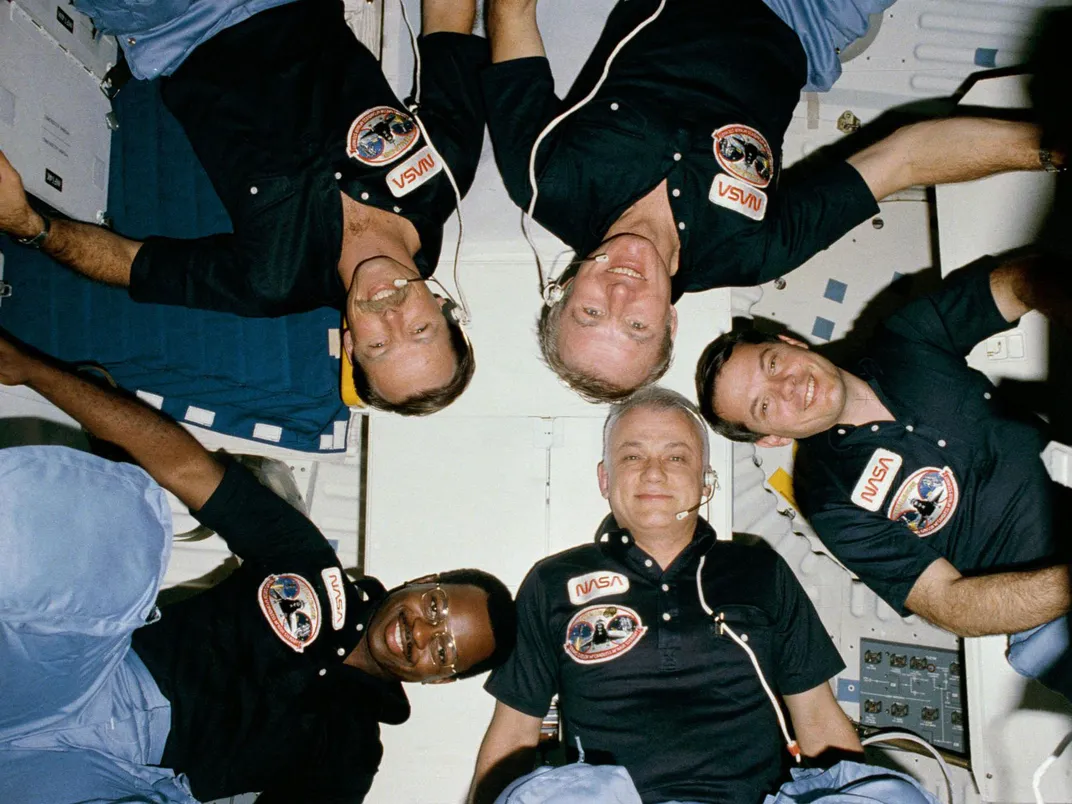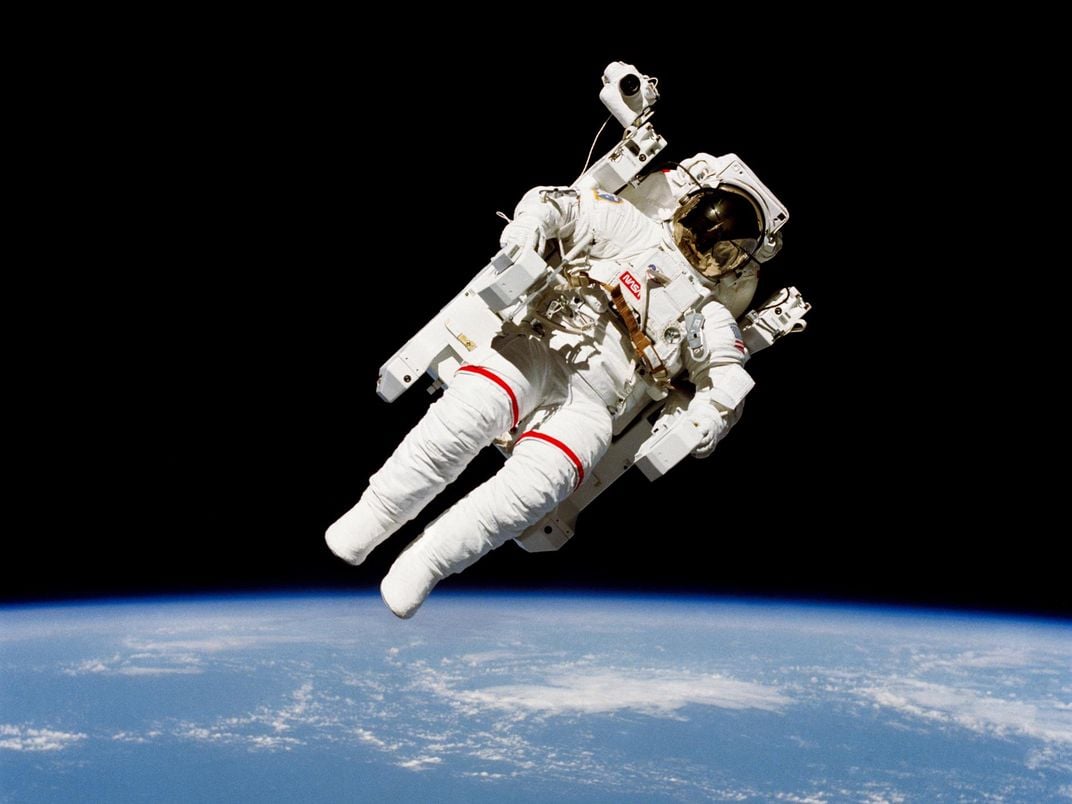
The first space shuttle mission of 1984, the launch of Challenger on the cool, windless morning of Friday, February 3, was apparently perfect—and eagerly trailed by a national press anticipating the first flights of what they called the “Buck Rogers jetpacks.” Formally known as the Manned Maneuvering Unit, the invention was a massive backpack equipped with gas thrusters that would allow astronauts to leave their spacecraft and float free in space for the first time in history. Reporters hoped that the spectacle would approach the theatrics of watching men walk on the moon more than a decade before. But, once in orbit, as the astronauts tackled the initial tasks of their weeklong mission, they experienced a trickle of humiliating failures: First, mission specialist Ronald E. McNair oversaw the launch of the Westar 6 communications satellite, which spun like a top out of the payload bay as planned, but then apparently vanished. Mission Control sheepishly admitted that they had simply lost it somewhere in space. “We can’t find it,” they told the astronauts over the radio link. “It’s not where it’s supposed to be.”
Then an experiment designed to test the shuttle’s facility for orbital rendezvous, using a Mylar balloon inflated with gas, also ended in farce when the balloon launched but promptly exploded; meanwhile, the shuttle toilet—which had always been troublesome—stopped working altogether. After waiting 48 hours to assure themselves that Palapa B-2, the second satellite due for release on the mission, would not suffer a similar fate to Westar 6, Mission Control gave the crew instructions to proceed with launching it. Seconds later, they lost contact with that, too. The total bill for the two mislaid satellites was at least $180 million.
By the time two men—Colonel Robert L. Stewart and Captain Bruce McCandless, one of the veteran astronauts who had signed on to NASA during the Apollo program and waited 18 years for this moment—stepped into the air lock to test the Manned Maneuvering Unit on the fifth day of the mission, NASA was desperate for good publicity.
The crew on Challenger, from top right clockwise; Vance D. Brand, Robert L. “Hoot” Gibson, Ronald E. McNair, Bruce McCandless and Robert L. Stewart NASA/https://tf-cmsv2-smithsonianmag-media.s3.amazonaws.com/filer_public/41/c9/41c93b3f-cfa7-450b-b6a2-c5123d2eab8a/s84-27026large_web.jpg)
They were not disappointed. At 7:25 on Tuesday morning, Houston time, McCandless fired the thrusters of his jetpack, rose slowly from Challenger’s cargo bay and flew clear of the spacecraft. He ran through his flight checklist, touching the joysticks with his fingertips to verify that the pack was working as it should: “Pitch down, pitch up, roll left, roll right,” he began, enunciating each word clearly into his headset microphone. Behind him, the pack trembled and shuddered like a nervous pony as its onboard computers automatically corrected his attitude with tiny whispers of gas from its two dozen nitrogen jets. Despite all his years of training and the bitter cold inside the suit, his palms prickled with sweat; his heart quickened. “It may have been a small step for Neil,” he said, “but it’s a heck of a big leap for me.”
Moving backward at no more than a foot a second, to preserve valuable fuel, McCandless watched as the gulf separating him from Challenger steadily expanded. Inside his suit, it became so cold his teeth began chattering; he switched off the internal cooling unit and continued sailing out into space. He looked for stars but saw only an enveloping darkness. The astronaut held a crude range finder—an aluminum bar etched with marks against which to measure his diminishing view of the shuttle’s cargo bay—to estimate the distance from the orbiter, and make sure he didn’t stray too far. Inside the cabin, McNair stood at the controls of the shuttle’s robot arm, ready to snatch McCandless to safety if necessary, and kept a laser tracker and Challenger’s TV cameras trained on him, transmitting live pictures to Houston and television stations around the planet. Meanwhile, Stewart remained behind in the payload bay, conducting a separate series of tests.
Still gazing back toward the shuttle, McCandless at last reached his destination and brought the jetpack’s progress to a halt: some 320 feet out in space, 170 miles above the Atlantic—a human satellite in orbit, traveling at 23 times the speed of sound. Yet the astronaut felt no sense of movement until he looked down and saw the planet rotating beneath his feet, a pin-sharp relief map unspooling at four miles per second: “Looks like Florida. It is Florida!” he said, his composure ebbing momentarily as he spotted Cape Canaveral below. “It really is beautiful.”
Looking out from the cockpit, pilot Robert L. “Hoot” Gibson centered the distant figure in the viewfinder of his Hasselblad—but then pulled the camera away from his eye, briefly startled by the power and clarity of the image he had framed. Gibson saw McCandless suspended alone in the abyssal blackness—angled slightly from the vertical, his white suit seeming to glow beneath the unfiltered sunlight of outer space, the luminous blue band of Earth’s atmosphere curving away beneath him. Gibson checked the settings on the camera, and then checked them again; he pointed the lens through the triple-paned cabin window and tilted it to level the horizon. He squeezed the shutter.
Meanwhile, McCandless continued to test the abilities of his experimental flying machine: He sailed back toward Challenger and then drew away once more; he dipped and rose, and turned somersaults. Like the other astronauts before him who had spoken rapturously of walking in space—back in 1965, Ed White had been so reluctant to return to his Gemini capsule that he described doing so as “the saddest moment of my life”—McCandless had hoped, if only for a few moments, to experience the noiseless solitude of being alone in the heavens; but the relentless chatter of the three audio feeds in his headset made it impossible.
McCandless in space NASA
The experimental plan had called, too, for the astronaut to orient himself to turn away from the shuttle when he reached the limit of his journey, and face out into the void. McCandless, a grizzled and shaven- headed 46-year-old third-generation Navy officer whose father and grandfather had both been awarded the Medal of Honor, was well acquainted with the limits of fear; as a Naval aviator, he had often landed his Phantom on the pitching deck of a carrier at night, and he believed that he would never do anything more dangerous. Yet, despite his intentions, not once in the entire spacewalk did he turn his back on Challenger, his sole means of returning home.
Almost six hours after their experiment had begun, McCandless and Stewart clambered back inside the spacecraft, sealed the door of the air lock behind them and removed their helmets. Down in Mission Control, the two astronauts’ wives fell into each other’s arms and wept.
Excerpted from Challenger: A True Story of Heroism and Disaster on the Edge of Space by Adam Higginbotham. Published by Avid Reader Press / Simon and Schuster. Copyright © 2024. All rights reserved.
A Note to our Readers
Smithsonian magazine participates in affiliate link advertising programs. If you purchase an item through these links, we receive a commission.
 Print
Print





